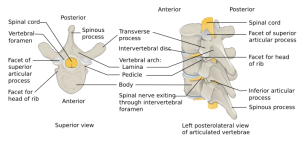Blunt neck trauma
Background
- Suspect vascular damage to cord if discrepancy between neuro deficit and level of spinal column injury
- Down syndome predisposes to atlanto-occipital dislocation
- RA predisposes to C2 transverse ligament rupture
- Cord injury is more likely if ant (vertebral bodies) AND post (spinal canal) columns are disrupted
- If find injury consider CT C-spine, x-ray rest of spine
- Penetrating injury rarely results in unstable fx
Prehospital Immobilization
Please see the NAEMSP National Guidelines for Spinal Immobilization
Diagnosis by Level
Vertebral fractures and dislocations types
- Cervical fractures and dislocations
- Thoracic and lumbar fractures and dislocations
C2 (Axis) Fractures
Odontoid fracture
Traumatic Spondylolisthesis ("Hangman's fracture")
C3-C7 Fractures
Anterior Wedge Fracture
- Only unstable if lose over half of vertebral height OR multiple adjacent wedge fractures
Flexion Teardrop Fracture
- Unstable
- Severe flexion > vertebral body colliding with the one below (shallow water diving injury, MVC deceleration)
- Most commonly at C5-C6
- Displacement of teardrop shaped fragment of antero-inferior portion of superior vertebra
- Leads to posterior displacement of vertebral body and disruption of posterior longitudinal ligament
- Associated with acute anterior cervical cord syndrome
Extension Teardrop Fracture
- Unstable
- Abrupt neck extension > anterior longitudinal ligament avulses anteroinferior corner
- Avulsed fragment is greater in height than width (contrast with flexion teardrop)
- Often occurs at C5-C7 associated with diving accidents
- Associated with central cord syndrome
Spinous Process Fracture (Clay shoveler's)
- Stable
- C7>C6>T1 avulsion fx; ; caused by extreme muscle flexion where spinous process is ‘pulled off’
- Isolated fracture of the spinous processes of the lower cervical vertebrae
- Management
- nonop
- collar for 10 days with ortho f/u
- r/o lamina and facet fx, r/o jumped facet
Cervical burst fracture
- Unstable if:
- Associated neurologic deficits
- Loss of >50% of vertebral body height
- >20 degrees of spinal angulation
- Compromise of >50% of spinal canal
- Axial compression > nucleus pulposus forced into vertebral body
- Imaging
- Lateral x-ray - Comminuted body and loss of vertebral height
- AP x-ray - Vertical fracture of the body
Vascular Injuries
- Carotid and vertebral artery injuries can occur with blunt c-spine trauma
- Half of patients present with initially normal neuro exam
- OR for carotid/vertebral artery injury of 8.6 with c-spine fracture
- OR for vertebral artery injury of 30.6 with transverse process fracture
- Vertebral angiography for transverse process fractures extending into transverse foramen or evidence of vertebral-basilar insufficiency(90% show dissection or occlusion of vertebral artery)
- Indications for screening (CTA or MRA) for vascular injury
- Unexplained neuro deficit with hyperflexion or extension injury
- Blunt trauma to neck or seatbelt injury
- C-spine or skull base fractures involving vascular foramina
- Le Fort II or III facial fractures
See Also
- Spinal Cord Trauma
- Spinal Cord Compression (Non-Traumatic)
- Neurogenic Shock
- C-spine (NEXUS)
- C-Spine X-Ray
- Fractures (Main)
- Unstable spine fractures
Source
- National Spinal Cord Injury Statistical Center (NSCISC). Spinal Cord Injury. Facts and Figures at a Glance. Birmingham, Ala: NSCISC; July 1996
- Ivy ME, Cohn SM. Addressing the myths of cervical spine injury management. Am J Emerg Med. Oct 1997;15(6):591-5
- Woodring JH, Lee C, Duncan V. Transverse process fractures of the cervical vertebrae: are they insignificant? J Trauma. June 1993; 34(6):797-802.
- Tintinalli's





